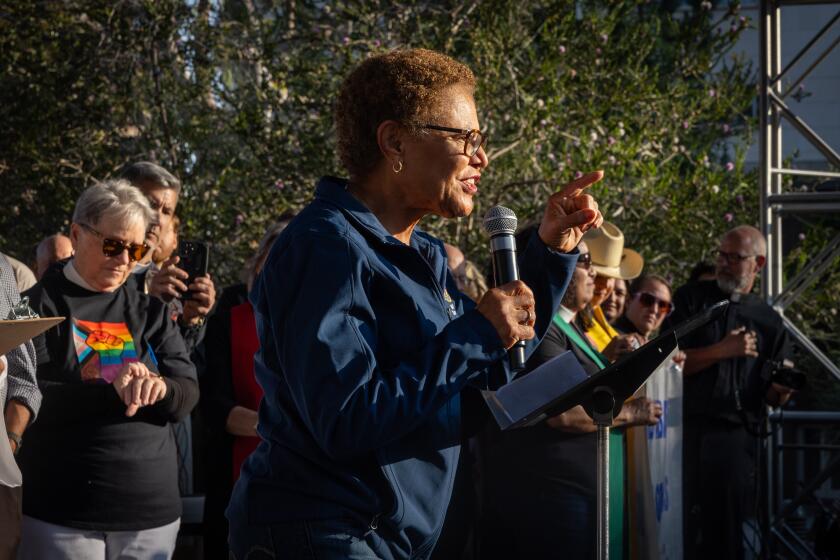‘Balkanization’ of the Valley : New names: Opinions vary, but most experts say the boundary changes may be a last-ditch effort by established homeowners to save the status quo.
- Share via
When thousands of San Fernando Valley residents demanded and received new names for their neighborhoods this year, the phenomenon prompted New Republic magazine to dub Los Angeles “the world capital of geographic self-invention.”
The changing communities are “all Norma Jean Bakers trying to be Marilyn Monroes,” the magazine said.
Despite that assessment, the changes have left urban planners, Realtors, political analysts and others grappling to find a more concrete explanation for the Valley’s sudden need to redefine and clarify community boundaries.
Opinions vary but most observers agree: The geographic landscape of the Valley is undergoing a significant transformation, which may be a last-ditch effort by established homeowners to preserve the Valley’s status quo.
“Balkanization is the theme of the year--I guess it’s infected the Valley as well,” said Ira Winn, professor of urban studies at Cal State Northridge. “It is interesting that this would happen at the same time that Europe is splitting apart.”
Los Angeles is separating “into turfs,” Winn said. “Everyone has to have their own and if your turf has a fancy name, then all the better.”
Steve Owen, president of the San Fernando Valley Board of Realtors, attributes the many changes to homeowners who simply want to live in more swank communities.
“It’s the old ego thing,” Owen said. “Everybody wants to have more, drive a better car, live in a better neighborhood. Seeing as how they can’t move their houses to a better neighborhood, they change the name to make themselves feel better.” ’
There have already been five such changes this year:
In February, Councilman Joel Wachs officially gave a section of North Hollywood the name Valley Village after residents argued that the community had been called that in past years.
In May, the community of North Hills was carved from Sepulveda. Councilman Hal Bernson approved the name change after about 86% of the homeowners signed petitions supporting it.
In August, an affluent section of Van Nuys including Chandler Estates, seceded and was officially named Sherman Oaks by Councilman Zev Yaroslavsky. Residents presented deeds showing the area was part of Sherman Oaks decades ago. Two weeks later Councilman Marvin Braude approved another section of Van Nuys for inclusion in Sherman Oaks.
Also in August, Bernson allowed residents in a small section of Granada Hills to join the newly created North Hills.
The predecessor of all these changes is West Hills, created in 1986 at the request of a dissident group of Canoga Park residents. Councilwoman Joy Picus approved the change, but later found herself in the center of a heated debate.
Shortly after winning approval, West Hills residents waged an intensive campaign to keep out their neighbors to the east, who also wanted to be a part of the new community. After much public discussion, Picus finally agreed to expand the West Hills boundaries to include other residents.
A few Valley community leaders have accused the secessionists of elitism and snobbery. They argue that residents should help cure the problems plaguing the communities instead of distancing themselves with a new address.
But residents behind the push to redesignate Valley neighborhoods deny charges of elitism. They say dissociating themselves from problem communities will result in increased property values and decreased automobile and homeowners insurance. Others say the changes will restore a neighborhood name that was lost when the U.S. Postal Service created ZIP codes in the 1960s. Richard Alarcon, the Valley-area coordinator for the mayor’s office, said that such changes are part of the city’s history and that he does not view them as elitism.
“I don’t think there’s any community in the Valley that wasn’t called something else” at some point, he said.
Some homeowners were confused because of contradictory designations and simply wanted “to know where they live,” he said. In a city where there is no single agency or governmental entity responsible for defining community boundaries, confusion is commonplace. The Thomas Guide, city maps, police boundaries and postal maps often contradict each other, designating the same area with a different community name.
Mike Davis, author of “City of Quartz: Excavating the Future in Los Angeles,” notes that the Valley has undergone drastic changes in recent years and contends that those changes have fueled the drive for new names.
“You have the urbanization of suburbia,” Davis said. “The Valley, which was 95% white in 1950 is probably at least 40% Latino, black and Asian. More of a class divide is clear between the East and West Valley.”
The rash of new names “is an expression of upper-scale, white homeowners attempting to distinguish themselves and divide themselves from the part of the Valley which is more urban . . . and filled with people of color,” Davis argues.
Instead of physically relocating as others did in the past, Valley residents have resorted to building “nomenclature walls to erect the maximum division between themselves and lower-income communities,” Davis said.
Winn and Davis compared the new names to gated communities.
“The upper class builds a real gate,” Winn said. “In a way the name change is the middle class’s gate. . . . People are tied into their property because it’s probably the largest single asset that they hold and they’re worried.”
But residents in the newly named communities who expect a surge in property value because of the new name may be indulging in wishful thinking, Owen said.
“You’re not going to change the spots on a cat,” he said. “Changing the name of a section . . . is not going to change it from a mid-range to an upper-range” neighborhood.
When Canoga Park residents seceded and created the community of West Hills in 1986, homeowners did see increases in property value, Owen said, but the increases stemmed from the market conditions in 1988 and 1989 and had little to do with the new name.
Owen said he has not seen any differences in market prices resulting from the recent renaming spree.
“It’s not having any impact, other than wreaking havoc on agents trying to show houses in the area and trying to keep up” with the changes, he said.
Comedian Shelly Berman, who now lives in Ventura County, was the honorary mayor of Canoga Park when West Hills was created and remembers the clamor surrounding the issue.
“Image matters,” he said. “If you can call yourself West Hills--wow, does that sound good. West Hills just italicizes itself in your mind.”
Since the creation of West Hills, each of the requested name changes has been granted without resistance from members of the council, whose only requirement has been that campaign leaders produce petitions signed by area homeowners. The people who request name changes are usually homeowners, well-established and with a disproportionate amount of political influence, Winn said.
“Politicians have more to risk by refusing the name change than by granting it,” Winn said.
Members of the council have said the only cost involved is that incurred by the Department of Transportation, which prints and puts up street signs marking new community boundaries. Others note the hours council staff must spend validating signatures on petitions.
For the Postal Service, neighborhood name changes can be costly and may actually result in a delay of mail, officials said.
After the latest round of changes, postal authorities complained that members of the council were unilaterally changing community boundaries without consulting or informing the Postal Service. Because the community boundaries have not been changed on postal maps, the new names may cause confusion and slow mail delivery. Of all the recent changes, the Postal Service officially recognizes only one, North Hills.
In July Bernson and U.S. Rep. Elton Gallegly (R-Simi Valley) went to Washington to ask the postmaster general to give North Hills a different ZIP code. Currently, the residents use a Sepulveda code.
Postal officials denied the request but did agree to allow North Hills residents to use the name in their addresses. Even that concession means postal workers will have to memorize new routing procedures and computers will have to be reprogrammed.
Other impacts that the new names will have on the city, if any, remain to be seen.
To Alarcon, it is a harmless procedure that has no real bearing on city government or the allocation of services.
“The city would provide the services no matter what the name of the community is,” he said.
To Davis it is an “insidious process” that stigmatizes the communities that are left behind, “which affects property values, quality of schools, and social services.” Ideals of common citizenry and responsibility in the city as a whole are eroded, he said.
“I’d really like to see some of the new leaders, people like Councilman Mark Ridley-Thomas, speak up on this question,” he said.
But that might take time. Name changes do not require a full vote from the City Council and a number of members outside the Valley seem unaware of the changes.
Council members Ridley-Thomas, Rita Walters and Richard Alatorre, whose districts are outside the Valley, declined to comment on the issue.
In the meantime Owen has his own solution to the dilemma.
“Drop all the names and just call it the Valley,” he said.
The Name Shuffle
Parts of these San Fernando Valley communities have recently changed names. DATE: 1986 FROM: Canoga Park TO: West Hills DATE: February, 1991 FROM: North Hollywood TO: Valley Village DATE: May, 1991 FROM: Sepulveda TO: North Hills DATE: August, 1991 FROM: Van Nuys TO: Sherman Oaks DATE: August, 1991 FROM: Granada Hills TO: North Hills
More to Read
Sign up for Essential California
The most important California stories and recommendations in your inbox every morning.
You may occasionally receive promotional content from the Los Angeles Times.













